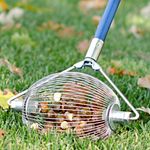
Because we’re gardeners and we’re working with blooming plants it’s bound to happen at some point; we’re going to get stung.
Of course, sometimes it isn’t the gardener that the bee stings, but the gardener’s kid or small grandchild, and it helps to know beforehand what you can slap onto the stinging and burning site that might actually stop the pain.
To be clear, it’s the honeybees that are truly committed when they sting people. Honeybees are the only bees that sacrifice themselves for that one good sting; so you have to give them props for that. Not so with wasps, hornets and yellow jackets. These guys are capable of stinging you over and over again if it’s on their agenda.
The first thing that needs to be done when treating a bee sting is to look for the stinger. If there’s one still attached, scrape it out with your fingernail carefully, but don’t be slow about it. If you take a good look at the stinger, you’ll see that the hind end of the bee is still attached as well.
The bee’s hind end contains a sac that holds venom. You can actually watch the sac pumping more venom into the skin the longer it sits there (ewww, that was hard to even write). So, you need to get that gross thing out of there ASAP.
The next thing that you really need to do – even if your kid is jumping up and down and screaming in your ear – is wash the sting with soap and water before applying any natural remedy. This helps ward off bacteria that could cause an infection later.
12 Natural Bee Sting Remedies
The pain and swelling remedy that works for one person may not do much for another, so I’ve compiled a short list of the ones that people claim as the best. The majority of these items can be found around the average household, but you may want to purchase a couple of them to have handy for the growing season.
1. Garlic cloves: This one is quite popular and is touted as one of the best for the pain of a sting. Crush a garlic clove to release the garlic juices and press it against the sting.
2. Lavender essential oils: Just a drop on the sting site is all you need. The essential oils in the lavender are supposed to neutralize the venom immediately.
3. Baking soda and water: This one seems to have been around forever, but it’s a favorite. Mix the baking soda and water to form a thick paste then slather it onto the skin. Don’t wash it off.
4. Peanut butter: This was a new one for me. Again, people everywhere seem to find it effective. I’m anxious to try it, I mean, I am; but I’m not, you know?
5. Plantain (Plantago spp.): Plantain is a common weed that apparently had medicinal properties when it comes to bee stings. It makes itself at home almost everywhere, but whether you can find it around your home or not will depend on how obsessed you are with your yard or garden.
In fact, if you’d like to plant plantain on purpose, there are some cultivars grown as ornamentals. They called P. major ‘Rubrifolia’ which has lovely purple foliage and P. major ‘Rosularis’ that has green bracts (in truth, they’re leaves) that look like green roses.
To use plantain as a bee sting treatment, chew up some of the leave to release its juices or firmly roll it between your thumb and fingers. Then press the juicy leaves against the sting.
6. Calendula (Calendula officinalis) flowers: Prepare flowers by crushing enough of them to get a good juice content and apply to sting.
7. Bee Balm (Monarda didyma) leaves: Prepare the leaves the same way as plantain.
8. Basil: Using crushed basil leaves is said to be extremely affective for pain caused by stings.
9. Onion: Cut an onion in half and press the inside of it (the juicy part) on the sting.
10. Honey: So, how ironic is this? I mean, it seems only fitting that if the bees have the sting; they also have the cure. Pour some honey on the affected site.
11. Parsley: I would crush quite a bit of parsley so you could really get some juice to try this one.
12. Apis Mellifica: Are you ready for more irony? Apis Mellifica is a homeopathic remedy that’s made from whole bees that’s suppose to work wonders on stings from all kinds of critters including fire ants. There are different potentcies and dosages so if you purchase some, follow the directions on the label.
Most of these natural remedies call for crushing or mixing ingredients, so it might not be a bad idea to invest in a mortar and pestle. A mortar and pestle is a small marble, stone, or wooden bowl with a little marble club-like thing used for crushing that looks like it belongs to cave people.
Fine Gardening Recommended Products

Chapin International 10509 Upside-Down Trigger Sprayer
Fine Gardening receives a commission for items purchased through links on this site, including Amazon Associates and other affiliate advertising programs.

Medium Nut Wizard 14" for English Walnuts, Chestnuts, Golf Balls
Fine Gardening receives a commission for items purchased through links on this site, including Amazon Associates and other affiliate advertising programs.

Plant Covers Freeze Protection 10 ft x 30 ft Floating Row Cover 0.9oz/yd²
Fine Gardening receives a commission for items purchased through links on this site, including Amazon Associates and other affiliate advertising programs.



















Comments
Log in or create an account to post a comment.
Sign up Log in